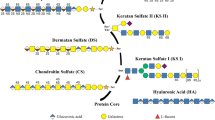Abstract
TwoLeishmania donovani glycoconjugate ligands for the internalization receptor on BALB/c peritoneal macrophages [fucose-mannose ligand (FML) and phosphate mannogalactan ligand (PMGL)] were shown to be species-specific in a comparative phagocytosis-inhibition test. Promastigotes ofL. donovani Sudan (LD1S),L. infantum, L. d. donovani, L. major (Jericho and Sudan),L. tropica, L. chagasi, L. mexicana venezuelensis, L. m. mexicana, L. m. amazonensis, L. m. pifanoi, L. m. garnhami, L. braziliensis braziliensis, L. m. amazonensis (Josefa),L. enrietti orL. adleri were incubated with macrophages in the presence of 10 μg/ml FML and PMGL purified fromL. donovani (LD1S). Parasite internalization was determined and compared with that obtained in control experiments. Specific inhibition of phagocytosis ranged from 83% (L. donovani LD1S) to 7% (L. m. amazonensis). We could distinguish groups ofLeishmania consistently with their geographic distribution and the clinical aspects of the disease. Analogous experiments withL. m. amazonensis glycoconjugates showed reciprocal results, with inhibition ranging from 76% (L. m. amazonensis) to 8% (L. donovani LD1S).L. chagasi remained separated from the Old World kalaazar agents. Possible phylogenetic implications of these observations are discussed.
Similar content being viewed by others
References
Baker JR (1963) Speculation on the family Trypanosomatidae Doflein 1901. Exp Parasitol 13:219–233
Barker PC, Butcher J, Gibson LJ, Williams MH (1985) Characterization ofLeishmania sp. by DNA hybridization probes. A laboratory manual. UNDP/World Bank/WHO Special Programme for Research and Training in Tropical Diseases WHO, Geneva
Beverley SM, Ismach R, McMahon-Pratt D (1986) Evolution of the genusLeishmania Ross, 1903 as revealed by comparisons of nuclear DNA restriction fragment patterns. In: Colloques Internationaux CNRS/INSERM. IMEEE, Montpellier, pp 265–267
Bray RS (1974)Leishmania. Annu Rev Microbiol 28:189–217
Chance ML, Walton BC (1980) Biochemical characterization ofLeishmania. In: Proceedings, Pan-American Health Organization Workshop, December 9–11. Pan-American Health Organization, Washington, pp 1–276
Chance ML, Peters W, Schory L (1974) Biochemical taxonomy ofLeishmania: I Observations on DNA. Ann Trop Med Parasitol 68:307–316
Gardener PJ, Chance ML, Peters W (1974) Biochemical taxonomy ofLeishmania: II. Electrophoretic variation of malate dehydrogenase. Ann Trop Med Parasitol 68:317–325
Jacobson RL, Slutzky GM, Greenblatt CL, Schnur LF (1982) Surface reactions ofLeishmania: I. Lectin mediated agglutination. Ann Trop Med Parasitol 76:45–52
Killick-Kendrick R, Ward RD (1981) Ecology ofLeishmania (workshop II). Parasitology 82:143–152
Lainson R (1985) Our present knowledge of the ecology and control of leishmaniasis in the Amazon region of Brazil. Rev Bras Med Trop 18:47–56
Lainson R, Miles MA, Shaw JJ (1981) On the identification of viscerotropic leishmanias. Ann Trop Med Parasitol 75:251–253
Lainson R, Shaw JJ, Silveira TT, Braga RR (1987) American visceral leishmaniasis: on the origin ofLeishmania chagasi. Trans R Soc Trop Med Hyg 81:517
Lumsden WHR (1974) Leishmaniasis and trypanosomiasis: the causative agents compared and contrasted. In: Trypanosomiasis and leishmaniasis, with special reference to Chagas' disease. Ciba Foundation Symposium ASP. Elsevier/Excerpta Medica/North Holland. Amsterdam, pp 3–27
McMahon-Pratt D, David JR (1981) Monoclonal antibodies that distinguish between New Worl species ofLeishmania. Nature 291:581–583
Mendonça-Previato L, Gorin PAJ, Braga AF, Scharfstein J, Previato JO (1983) Chemical structure and antigenic aspects of complexes obtained from epimastigotes ofTrypanosoma cruzi. Biochemistry 22:4980–4987
Miles MA (1985) Biochemical identification of the leishmanias. Pan-Am Health Organ Bull 19:343–353
Moreno G, Rioux JA, Lanotte G, Pratlong F, Serres E (1986) Le complexeLeishmania donovani s.l. In: Colloques Internationaux CNRS/INSERM, IMEEE, Montpellier, pp 105–117
Newton BA (1976) Biochemical approaches to the taxonomy of kinetoplastid flagellates. In: Lumsden WHR, Evans DA (eds) Biology of Kinetoplastida, vol 2. Academic, New York, pp 1–116
Palatnik CB, Previato JO, Gorin PAJ, Mendonça-Previato L (1985) Partial chemical characterization of the carbohydrate moieties inLeishmania adleri glycoconjugates. Mol Biochem Parasitol 14:41–54
Palatnik CB, Previato JO, Gorin PAJ, Mendonça-Previato L (1987)Leptomonas samueli glycoconjugates. Comparison withHerpetomonas samuelpessoai. Comp Biochem Physiol B 86:593–599
Palatnik CB, Borojevic R, Previato JO, Mendonça-Previato L (1989) Inhibition ofLeishmania donovani promastigote internalization into murine macrophages by chemically defined parasite glycoconjugate ligands. Infect Immun 57:754–763
Saf'janova WM (1986) The problems of classification and phylogeny ofLeishmania. In: Colloques Internationaux CNRS/INSERM. IMEEE, Montpellier, pp 247–255
Santoro F, Lemesre JL, Rizvi FS, Afchain D, Sadigursky M (1986) Specificité au niveau des proteines de surface des promastigotes deLeishmania donovani (Laveran et Mesnil, 1903),Leishmania infantum Nicolle, 1908 etLeishmania chagasi Cunha et Chagas, 1937. In: Colloques Internationaux CNRS/INSERM. IMEEE, Montpellier, pp 71–75
Schnur LF, Zuckerman A, Greenblatt CL (1972)Leishmania serotypes as distinguished by the gel diffusion of factors excreted “in vitro” and “in vivo”. Isr J Med Sci 8:932–942
Vickerman K (1976) The diversity of the kinetoplastid flagellates. In: Lumsden WHR, Evans DA (ed) Biology of the Kinetoplastida. Academic, London New York San Francisco, pp 1–34
Wallace FG (1966) The trypanosomatid parasites of insects and arachnids. Exp Parasitol 18:124–193
World Health Organization (1984) The leishmanias. WHO Tech Rep Ser 701:1–140
Author information
Authors and Affiliations
Rights and permissions
About this article
Cite this article
Palatnik, C.B., Previato, J.O., Mendonça-Previato, L. et al. A new approach to the phylogeny ofLeishmania: species specificity of glycoconjugate ligands for promastigote internalization into murine macrophages. Parasitol Res 76, 289–293 (1990). https://doi.org/10.1007/BF00928181
Accepted:
Issue Date:
DOI: https://doi.org/10.1007/BF00928181




